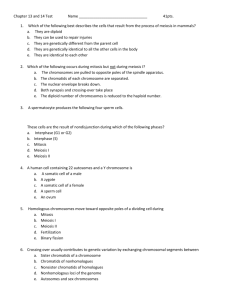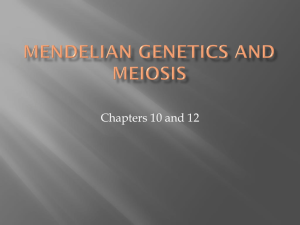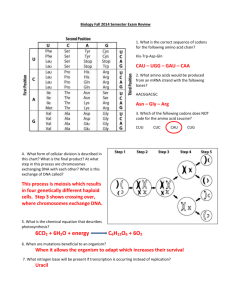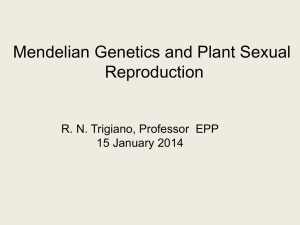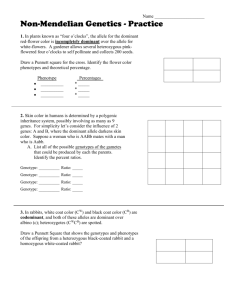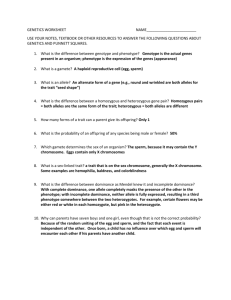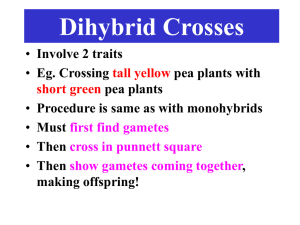Mendel*s Laws and Punnett Square Notes
advertisement
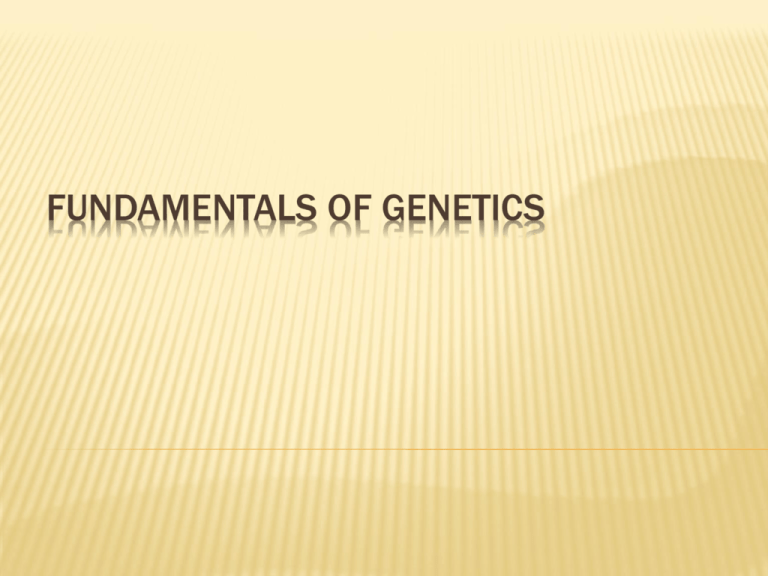
FUNDAMENTALS OF GENETICS WEDNESDAYS WARMUP?!?? Humans inherit a set of chromosomes from each parent, yet the chromosomes are not identical to the same chromosomes in either parent. How can it be that we inherit chromosomes from our parents, but they’re NOT identical to any of our parents’ chromosomes? INHERITANCE & GENETICS Every living thing – plant or animal, microbe or human being – has a set of characteristics inherited from its parent or parents. Genetics – Study of heredity CHROMOSOMES & GENES Chromosome - Very long, continuous single piece of DNA, contains many genes Gene - Sequence of DNA that codes for a protein and thus determines a trait WHAT IS AN ALLELE? Alleles are the different possibilities for a given trait. Every trait has at least two alleles (one from the mother and one from the father) Example: Eye color – Brown, blue, green, hazel Examples of Alleles: A = Brown Eyes a = Blue Eyes B = Green Eyes b = Hazel Eyes HOMOLOGOUS CHROMOSOMES Homologous Chromosomes - Term used to refer to chromosomes that each have a corresponding chromosome from the opposite-sex parent. Both chromosomes have all the same genes in the same location, but different ‘versions’ of those genes. HAPLOID VS. DIPLOID Haploid - Term used to refer to a cell that contains only a single set of chromosomes and therefore only a single set of genes; “one set”; represented by N. Diploid - Term used to refer to a cell that contains both sets of homologous chromosomes; “two sets”; represented by 2N. GAMETE VS. ZYGOTE Gamete - A mature sexual reproductive cell that has a haploid numbers that unites with another cell to form a new organism. Example: Sperm or egg cell Zygote - The cell formed by the union of two gametes. Sexual Reproduction - Process by which two cells from different parents unite to produce the first cell of a new organism. Haploid sperm (gamete) Haploid egg (gamete) Diploid zygote 1n 1n 2n + = Remember, in SEXUAL reproduction… …to form a …which HAPLOID grows gametes into a DIPLOID DIPLOID join…fetus zygote SEXUAL REPRODUCTION Sexual Reproduction – Process by which two cells from different parents unite to produce the first cell of a new organism. MEIOSIS Meiosis - Process by which the number of chromosomes per cell is cut in half through the separation of homologous chromosomes in a diploid cell; Haploid (N) gamete cells are produced from diploid (2N) cells. Begin with Diploid (2N) Cells Produce Haploid (N) Cells FOUR GAMETES ARE MADE DURING CELL DIVISION BY MEIOSIS. THE GAMETE CELLS HAVE HALF THE NUMBER OF CHROMOSOMES AS THE ORIGINAL CELL. MEIOSIS Meiosis usually involves two distinct divisions: 1. 2. Meiosis 1 Meiosis 2 MEIOSIS 1 Prior to meiosis I, each chromosome is replicated. The cells then begin to divide in a way that looks similar to mitosis. One big difference: Each chromosome pairs with its corresponding homologous chromosome to form a structure called a tetrad and exchange portions of their chromatids in a process called crossing-over. MEIOSIS 1 Tetrad - Structure containing 4 chromatids that forms during meiosis Crossing Over - Process in which homologous chromosomes exchange portions of their chromatids or alleles. CROSSING OVER Produces new combinations of alleles. Meiosis 1 is similar to mitosis except: The two cells produced by meiosis I have sets of chromosomes and alleles that are different from each other and from the diploid cell that entered meiosis I. MEIOSIS 2 Two cells produced by meiosis I now enter a second meiotic division. Unlike the first division, neither cell goes through a round of chromosome replication before entering meiosis II. Those four daughter cells now contain the haploid number (N)—just 2 chromosomes each. GAMETE FORMATION In male animals, the haploid gametes produced by meiosis are called sperm. In female animals, generally only one of the cells produced by meiosis is involved in reproduction. This female gamete is called an egg in animals. In females, cell divisions at the end of meiosis I and meiosis II are uneven. A single cell, which becomes an egg, receives most of the cytoplasm. The other three cells are known as polar bodies and usually do not participate in reproduction. NONDISJUNCTION The most common error in meiosis occurs when homologous chromosomes fail to separate. This is known as nondisjunction. Results in abnormal numbers of chromosomes in gametes. Example - Down syndrome, which results when an individual has three copies of chromosome 21. MITOSIS VS. MEIOSIS Mitosis: Produces two genetically identical diploid cells. Meiosis: Produces four genetically different haploid cells. MITOSIS VS. MEIOSIS Mitosis Allows an organism's body to grow and replace cells. Used in asexual reproduction to produce a new organism. New (daughter) cell is identical to the parent cell and to each other. Produces two diploid (2N) daughter cells. Meiosis Used in sexual reproduction to produce gametes. New (daughter) cells are genetically different from the parent cells and from one another. Produces four haploid (N) cells. Is responsible for the genetic variation among species. INHERITANCE & CELL TYPE You can only inherit a trait from gametes, not other somatic (body) cells! Mutations within somatic (body) cells do not affect future offspring genes. Whereas, mutations within gametes do alter offspring genes. For example, if your mother has skin cancer, you will not inherit this mutation because the mutation is on her somatic (body) cells and these are not inherited. Formation of twins video clip: http://www.pennmedicine.org/encyclopedia/e m_DisplayAnimation.aspx?gcid=000058&ptid= 17 GREGOR MENDEL Mendel carried out his work with ordinary garden peas. Mendel studied 7 different pea plant traits such as seed color or plant height. Trait - Specific characteristic that varies from one individual to another. Each of the 7 traits Mendel studied had two contrasting characters. For example, green seed color and yellow seed color. GREGOR MENDEL’S EXPERIMENTS Mendel crossed plants with each of the seven contrasting characters and studied their offspring. Parental or P Generation Each original pair of plants F1 or First Generation – The first set of offspring from the parents GREGOR MENDEL’S FIRST SET OF EXPERIMENTS 1. Mendel crossed a tall and short plant and all offspring were tall. All of the offspring had the character of only one of the parents. Mendel concluded that some alleles are dominant and others are recessive (called the Principle of Dominance) GREGOR MENDEL’S SECOND SET OF EXPERIMENTS 2. He then crossed the F1 generation with itself to produce the F2 offspring (Tall x Tall) Some of the traits had reappeared - some were tall and some were short. The Law of Segregation was concluded (the two alleles segregate from each other so that each gamete carries only a single copy of each gene). MENDEL'S LATER EXPERIMENTS: TWO-FACTOR CROSSES 1. Crossed round, yellow pea plants with wrinkled, green pea plants All offspring were round yellow peas 2. He then crossed those offspring (F1) together to produce the F2 generation and the offspring were a mixture of all traits. MENDEL'S CONCLUSIONS FROM HIS TWOFACTOR CROSSES Mendel concluded that genes for different traits can segregate independently during the formation of gametes (called the Law of Independent Assortment) These genes that segregate independently do not influence each other’s inheritance. Helps account for the many genetic variations observed in plants, animals, and other organisms. DOMINANT VS. RECESSIVE Dominant - Masks the other trait; the trait that shows if present Represented by a capital letter R Recessive – An organism with a recessive allele for a particular trait will only exhibit that trait when the dominant allele is not present; Will only show if both alleles are present Represented by a lower case letter r DOMINANT & RECESSIVE PRACTICE T – straight hair t - curly hair TT - Represent offspring with straight hair Tt - Represent offspring with straight hair tt - Represents offspring with curly hair HOMOZYGOUS VS. HETEROZYGOUS Homozygous – Term used to refer to an organism that has two identical alleles for a particular trait (TT or tt) Sometimes called purebred Heterozygous - Term used to refer to an organism that has two different alleles for the same trait (Tt) Sometimes called hybrid RR rr Rr GENOTYPE VS. PHENOTYPE Genotype – The genetic makeup of an organism; The gene (or allele) combination an organism has. Example: Tt, ss, GG, Ww Phenotype – The physical characteristics of an organism; The way an organism looks Example: Curly hair, straight hair, blue eyes, tall, green PUNNETT SQUARES Punnett Square – Diagram showing the gene combinations that might result from a genetic cross Used to calculate the probability of inheriting a particular trait Probability – The chance that a given event will occur PUNNETT SQUARE Parent Parent Offspring HOW TO COMPLETE A PUNNETT SQUARE Y-Yellow y-white Genotype: 1:2:1 (YY:Yy:yy) 25%, 50%, 25% Phenotype: 3 Yellow, 75% 1 White, 25% YOU TRY IT NOW! Give the genotype and phenotype for the following cross: TT x tt (T = Tall and t = Short) TT X TT Step One: Set Up Punnett Square (put one parent on the top and the other along the side) T t t T TT X TT Step Two: Complete the Punnett Square T t t T Tt Tt Tt Tt TT X TT Step Three: Write the genotype and phenotype T t t T Tt Tt Tt Tt Remember: Each box is 25% Genotype: 4 – Tt or 100% Phenotype: 100% Tall YOU TRY IT NOW! Give the genotype and phenotype for the following cross: Tt x tt TT X TT Step One: Set Up Punnett Square (put one parent on the top and the other along the side) T t t t TT X TT Step Two: Complete the Punnett Square T t t t Tt tt Tt tt TT X TT Step Two: Complete the Punnett Square T t t t Tt tt Tt tt Remember: Each box is 25% Genotype: Tt - 2 (50%) tt - 2 (50%) Phenotype: 50% Tall 50% Short INCOMPLETE DOMINANCE Incomplete Dominance - Situation in which one allele is not completely dominant over another. Example – Red and white flowers are crossed and pink flowers are produced. CODOMINANCE Codominance - Situation in which both alleles of a gene contribute to the phenotype of the organism. Example – A solid white bull is crossed with a solid brown cow and the resulting offspring are spotted brown and white (called roan). + MULTIPLE ALLELES Multiple Alleles- Three or more alleles of the same gene. Even though three or more alleles exist for a particular trait, an individual can only have two alleles - one from the mother and one from the father. EXAMPLES OF MULTIPLE ALLELES 1. Coat color in rabbits is determined by a single gene that has at least four different alleles. Different combinations of alleles result in the four colors you see here. EXAMPLES OF MULTIPLE ALLELES 2. 3. Blood Type – 3 alleles exist (IA, IB, and i), which results in four different possible blood types Hair Color – Too many alleles exist to count There are over 20 different shades of hair color. MULTIPLE ALLELES There Are Always Multiple Alleles! Genetic inheritance is often presented with straightforward examples involving only two alleles with clear-cut dominance. This makes inheritance patterns easy to see. But very few traits actually only have two alleles with clear-cut dominance. As we learn more about genetics, we have found that there are often hundreds of alleles for any particular gene. We probably know this already - as we look around at other people, we see infinite variation. POLYGENIC TRAIT Polygenic Trait - Trait controlled by two or more genes. Polygenic traits often show a wide range of phenotypes. Example: The wide range of skin color in humans comes about partly because more than four different genes probably control this trait. Human eye color DIHYBRID CROSSES Let’s cross a homozygous tall (TT), homozygous yellow seed (YY) plant with a short (tt), green seed (yy) plant. Tall is dominant to short and green is dominant to yellow. TTYY x ttyy These are the genotypes of the two plants. INDEPENDENT ASSORTMENT Mendels’ principle of Independent Assortment states that genes for different traits can segregate independently during the formation of gametes (eggs & sperm in animals, eggs and pollen in plants). We must first get all the possibilities of gametes for each parent! First T TTYY TY Gamete 1 = sperm, egg, pollen . . . with first Y INDEPENDENT ASSORTMENT Mendels’ principle of Independent Assortment states that genes for different traits can segregate independently during the formation of gametes (eggs & sperm in animals, eggs and pollen in plants). We must first get all the possibilities of gametes for each parent! First T TY Gamete 1 TTYY TY Gamete 2 with second Y INDEPENDENT ASSORTMENT Mendels’ principle of Independent Assortment states that genes for different traits can segregate independently during the formation of gametes (eggs & sperm in animals, eggs and pollen in plants). We must first get all the possibilities of gametes for each parent! Second T TY Gamete 1 TY Gamete 2 TTYY with first Y T Y Gamete 3 INDEPENDENT ASSORTMENT Mendels’ principle of Independent Assortment states that genes for different traits can segregate independently during the formation of gametes (eggs & sperm in animals, eggs and pollen in plants). We must first get all the possibilities of gametes for each parent! Second T TY Gamete 1 TY Gamete 2 TTYY with second Y TY Gamete 3 T Y Gamete 4 DIHYBRID PUNNETT SQUARE Put all the possible combinations of alleles for Parent 1 along the top P1 = TTYY TY P2 = ttyy Put all the possible combos of alleles for Parent 2 along the side TY TY ty ty ty ty Will be F1 Generation TY DIHYBRID PUNNETT SQUARE Complete the punnett square. TY ty TTYy ty TTYy ty TTYy ty TTYy TY TY TY DIHYBRID PUNNETT SQUARE TY TY TY TY ty TtYy TtYy TtYy TtYy ty TTYY TtYY TtYY TTYY ty TTYY TTYY TTYY TTYY ty TTYY TTYY TTYY TTYY DIHYBRID PUNNETT SQUARE TY TY TY TY ty TtYy TtYy TtYy TtYy ty TtYy TtYy TtYy TtYy ty TtYy TtYy TtYy TtYy ty TtYy TtYy TtYy TtYy DIHYBRID PUNNETT SQUARE TY Ty tY ty TY Ty tY ty TTYY TTYy TtYY TtYy When you pair up the gametes from the two plants, always put like letters together and within the like letters, put the CAPITAL letter in front of the lowercase letter. DIHYBRID PUNNETT SQUARE Genotype ratio: TtYy - 16/16 or 100% Phenotype ratio: Tall, Yellow ty 16/16 or 100% ty TY TY TY TY TtYy TtYy TtYy TtYy TtYy TtYy TtYy TtYy ty TtYy TtYy TtYy TtYy ty TtYy TtYy TtYy TtYy DIHYBRID PUNNETT SQUARE Let’s cross two of the plants from the F1 generation. We need to pair up the genes which can be given to each gamete (egg and pollen). TtYy T Y T y t Y x TtYy t y DIHYBRID PUNNETT SQUARE TY TY Ty tY ty Ty tY ty Both the plants can give the same gene combinations to their gametes, so the pairs along the top and down the side are the same. DIHYBRID PUNNETT SQUARE TY Ty tY ty TY TTYY TTYy TtYY TtYy Ty ???? ???? ???? ???? tY ???? ???? ???? ???? ty ???? ???? ???? ???? Your Turn!! DIHYBRID PUNNETT SQUARE TY Ty tY ty TY TTYY TTYy TtYY TtYy Ty TTYy TTyy TtYy Ttyy tY TtYY TtYy ttYY ttYy ty TtYy Ttyy ttYy ttyy F2 generation DIHYBRID PUNNETT SQUARE Genotype and phenotype ratios? TY Ty tY ty TY TTYY TTYy TtYY TtYy Ty TTYy TTyy TtYy Ttyy tY TtYY TtYy ttYY ttYy ty TtYy Ttyy ttYy ttyy PHENOTYPE RATIO TTYY - 1 TTYy - 2 TtYY - 2 TtYy - 4 TTyy - 1 Ttyy - 2 ttYY - 1 ttYy - 2 ttyy - 1 Tall, Yellow – 9 or 9/16 or ~56% chance that the offspring will be tall and yellow Tall, Green – 3 or 3/16 Short, Yellow – 3 or 3/16 Short, Green – 1 or 1/16
